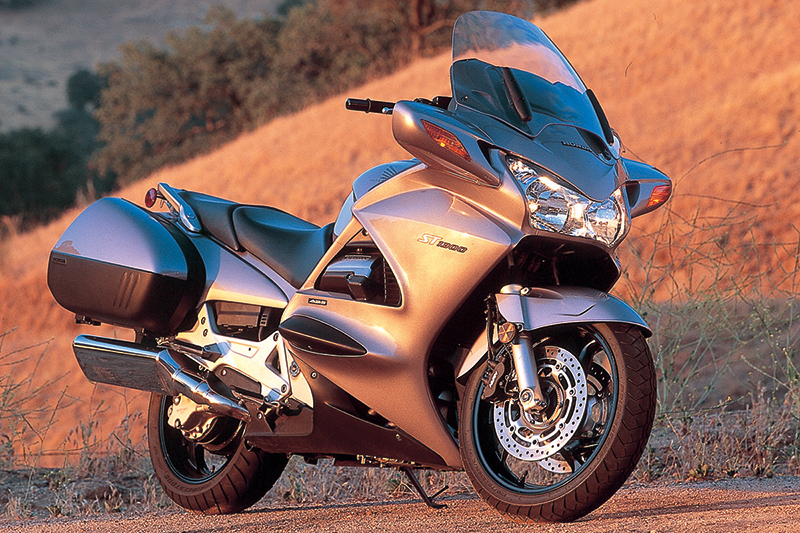2003 Honda ST1300 ABS

Road Test Review
Most motorcycles come and go. Their pictures appear in the magazines, then units arrive at the dealer’s door with some excitement and activity. A few years later they’re obsolete, blown out at discount prices, victims of technology’s endless upward spiral.
A few other motorcycles come and stay for many years, buoyed by the validity and competent interpretation of their pure concept. In this latter category are bikes like the Honda GL1500 Gold Wing dresser of 1988, and the 1990 Honda ST1100 sport tourer. Both hung around about a dozen years with occasional updates. While the Wing redefined its category and became the preeminent dresser tourer, the ST1100 went along more quietly, a fine sport tourer among several others.
In developing a successor to the ST1100, Honda has attempted to enlarge upon both its sporting abilities and its touring range and comfort. We’re here to assure you that, with the new 2003 ST1300, Honda has done it right. The styling is clean, crisp and modern, it addresses all the old 1100’s shortcomings, and is much quicker, sportier, more comfortable and much more pleasurable on a winding road. As with the previous bike, Honda is offering the ST1300 in both a standard ($12,999) and an ABS version ($14,499), the latter with an electrically adjustable windscreen and anti-lock brakes.
Honda approached the ST1300’s development by vastly refining and expanding upon the ST1100 concept. Like the original, the ST1300 is powered by a liquid-cooled, longitudinally mounted 90-degree V-4 engine with four valves per cylinder, and shaft final drive. Its all-enclosing, sleek bodywork incorporates removable saddlebags. Beyond those basics, the details have changed considerably.
Rather than steel, the new bike’s “tuned flex” frame is composed of triple box-section aluminum spars. Honda says it’s much stronger than the original, yet weighs 2.4 pounds less. Likewise, the new aluminum swingarm is lighter by 1.9 pounds.
The V-4 engine is also all-new, its oversquare bore and stroke of 78 x 66mm resulting in a displacement of 1,261cc. Compression ratio has been increased from 10.0 to 10.8:1. Honda recommends 92-PON (Pump Octane Number, or R+M/2) fuel for best performance, but the bike has an anti-knock sensor so it gets by on fuels rated as low as 87 just fine. Like other Honda sportbikes, the ST utilizes aluminum-composite cylinder sleeves for wear resistance and heat dissipation, and silent-type cam chains instead of wider belts. The latter is part of the reason the engine is now 2 inches shorter front-to-back.
With a 360-degree crankshaft and dual counterbalancers, the engine is smooth enough that Honda engineers solidly mounted it as a stressed member in the chassis. The drivetrain is equipped with dampers on the transmission mainshaft, clutch and driveshaft.
In the interest of improved breathing its DOHC-actuated, four valves per cylinder have been increased in size from 27.5 to 31mm (intake), and from 23 to 27mm (exhaust), and their included angle has been reduced to 26 degrees. The valve train retains the shim-under-bucket adjustment system; valve inspection intervals remain 16,000 miles. Programmed Fuel Injection (no choke is needed) delivers fuel via four 36mm downdraft throttle bodies with eight laser-drilled nozzle holes per injector. With two exhaust catalyzers, the bike already meets CARB 2008 emissions standards.
Hit the starter and the new V-4 sounds familiar, retaining the ST1100’s mechanical whirr at lower engine speeds, only now with a decided snarl at higher rpm. Pull in the hydraulically actuated clutch and the cassette-type five-speed transmission snicks into gear, its throws noticeably precise. While the ST1100 was very high geared, Honda has lowered the gearing on the 1300 by about five percent for additional acceleration punch. The powerband is wide and the delivery silky, with a snarly rush coming at about 5,000 rpm up to the bike’s 9,500-rpm redline. Rear-wheel peak horsepower is up 22 to about 111 at 7,750 rpm, and peak torque bumped by about 12 pounds-feet to 83.6 at 6,100 rpm. Check out the shape of the bike’s torque curve on the dyno chart, too-we can’t remember seeing one so flat.
We also recently sampled a 2002 ST1100, and by comparison the old bike feels softer powerwise and quite tall. Though very stable, it did not like changing direction swiftly. At extreme lean angles the front end began to feel very heavy, as if it wanted to tuck, which eroded my desire to push it hard. My knees smacked the fairing.
Honda expended considerable effort to provide the new ST1300 with a sportier ride and handling. In addition to lightening the frame and swingarm, it pared away unsprung weight. The front wheel lost 2.7 pounds, and the rear nine ounces; a similar diet reduced the front brake rotors by 4.7 pounds, and the rear by 10.5 ounces.
Wheelbase was shortened 2.5 inches to 58.7 inches, and rake tightened from 27.3 to 26 degrees. That new, shorter engine was moved forward and down, and the rider 1.6 inches farther forward. Fork diameter has been increased from 41 and 43mm on the ST1100s to 45mm for the state-of-the-art cartridge fork on both ST1300s. The rear Pro-Link single shock offers spring preload adjustment with 1.2 inches of range and a readily accessible hand wheel, and a rebound damping adjuster (for which you need a screwdriver).
Go tearing through the countryside and you’ll notice immediately that the ST1300 steers much more quickly, and rolls into turns much more easily and with less effort than its predecessor. Even with 21 pounds less weight than the comparable ST1100 ABSII model, of course, at 716 pounds wet the rider is always aware that the ST1300 ABS is a heavy motorcycle. The non-adjustable cartridge fork balances precision with plushness, and is remarkably well controlled for a bike of this heft. The rear suspension is likewise well controlled and plush, with an acceptable range of damping adjustment to handle carrying a passenger and loads.
The fly in the ointment is that driveline lash on/off throttle can be annoying, especially on bumpy pavement. Also, a lot of heat pours out the right side of the engine on warm days.
As with some other Honda models, the ST1300 has a linked braking system (LBS). Actuating either the front or rear brake also, through a hydraulic linkage, actuates the other. Pulling the front brake lever actuates the outer two pistons on each front brake caliper, and the middle piston of the rear caliper. Hitting the rear brake pedal actuates the two outer pistons on the rear disc, and the center piston on each of the front discs. The amount of braking force from the opposite wheel is controlled by a proportional control valve, with more pressure always going to the brake that was actuated with most force.
Returning to the fork for a moment, the system incorporates a delay valve to slow initial front brake response. This minimizes front-end dive so well under hard braking that it rivals BMW’s superb Telelever fork system for its anti-dive qualities. The anti-lock brake system provided quick, secure stops on a variety of surfaces, without any kickback at the lever.
Remove the ST1300’s two-piece seat and, by means of an easily adjusted bracket, the rider’s portion can be placed 30.5, 31.1 or 31.7 inches above the ground. Tilt can also be controlled, and the seat can be repositioned an inch fore and aft. Not only were the ranges useful, but the seat was also very cushy and comfortable.
On both models the windshield offers up to 2.3 inches of manual vertical adjustment by removing two screws per side and repositioning it. The ABS model includes an electrically adjustable windshield, which offers an uncommon range of 7.5 inches, along with 13 degrees of tilt. The shield actuates by a thumb switch near the left grip, and can be left anywhere throughout its range. It provided all the coverage my 6-foot frame could want-and that was in the lower manual position.
With the shield parked in its low setting, windblast pours over the top, striking the rider about mid chest. As the shield rises, the wind begins to come around the sides and draw the rider forward. At the top of shield travel the wind is shunted over the rider’s helmet and all suddenly becomes very quiet. Here, in a cocoon of mostly still air, the ride is mostly silent and unruffled, except for that spillover from the sides; even the passenger benefits from the protection.
While protection is very good, the wind coming over the shield is noisy through much of its travel-you’ll still want earplugs for long rides. Some riders may feel confined looking through the shield. Honda also states that the ST will deliver about seven to eight percent better fuel mileage with the shield set low.
The metal fuel tank, broad and flat-topped, welcomes a magnetic tankbag. It holds 5.5 gallons in the conventional location, and another 2.2 gallons in a sub-tank under the seat, for 7.7 gallons total capacity. With fuel mileage during our test of 42.6 mpg, this translates to a very healthy range of approximately 328 miles.
Speaking of mileage, the ST1300’s gauge package includes an LED display that has both average and current fuel-economy readouts. It also includes a clock, a fuel gauge, and engine temperature and ambient temperature gauges. Though the display has a high/low illumination setting, it can be difficult to see in the daytime.
For your touring pleasure the ST1300 includes hard-sided saddlebags that are styled with the bike and function very well. They are keyed with the ignition, and their clamshell-style door drops down to expose a wide, deep body area tapering toward the front. They will hold a large full-face helmet, or about 35 liters of gear. The key cannot be removed with the bags unlocked, which ensures that they won’t open accidentally underway, though this can be a trifle inconvenient at other times.
The bags are detached by unlocking and raising a hinged cover latch on either side of the luggage rack support. Lift the bag’s hinged handle, pull up and away, and it easily comes free. Replacing the bags requires a bit more fiddling, but it becomes easier with practice. Internal luggage straps are not provided, but inner liner bags as well as a tankbag are coming as options soon.
The ST rides on Bridgestone 020 radial sport-touring tires (Dunlops will also be available), a 120/70-ZR18 front and a 170/60-ZR17 rear. They enhance the bike’s sporty feel, but we wonder about their longevity. At about 3,500 miles the rear tire tread was at the end of its useful life, though the front had perhaps another 1,000 or more to go.
The ST offers many of the little amenities, including two helmet hooks, tipover bars hidden below plastic covers, two fairing pockets, excellent mirrors that pop off upon impact, underseat storage to hold a pair of winter gloves, a luggage rack and a 660-watt alternator. The front brake lever has an adjuster wheel to set the distance from the lever to the grip, but the clutch lacks one. It even has an electric headlight adjuster. Conspicuous by their absence are an electric accessory plug, heated grips (Honda says these are coming), saddlebag interior straps and a trunk, all usually either standard or available with state-of-the-art sport tourers.
Honda’s new ST1300 is a marvel of precision. It’s in the way the power rolls on, the way it shifts, its fine suspension, its brakes. It insulates from the road without being isolating. The ST1300 is a more-than worthy successor to the ST1100, and raises the bar for all sport tourers once again. We can’t say if this velvet hammer will last another dozen years, but we can say that the chances look very good indeed.
